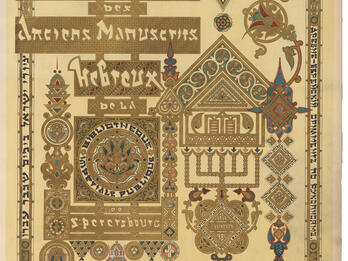The Reformed Heder in Pinsk
Ḥayah Weizmann-Lichtenstein
1904
The Zionist movement in Pinsk expanded and developed, and some of the best [local] activists concentrated their efforts there. Activities, such as lectures, debates, and the sale of Shekels and Jewish Colonial Trust shares1 took place at the Zionist club that opened following the First Zionist Congress [in 1897]. Yet this institution proved unable…
Creator Bio
Ḥayah Weizmann-Lichtenstein
Born in Motele, Russian Empire (today Motal, Belarus), Ḥaya Weizmann-Lichtenstein was brought up in a traditional home, one of fifteen children; among her siblings was Chaim Weizmann, later the first president of Israel. Her parents provided Weizmann-Lichtenstein an education in heder alongside boys, which was unusual for the time and place. In 1897, she received her teaching credentials in nearby Pinsk, where her family had moved to advance the educational prospects of her siblings. Having become involved in Zionist causes during her years as a student, Weizmann-Lichtenstein formed a Zionist youth association for girls while working as a schoolteacher in Pinsk. In 1902, she married Abraham Lichtenstein, a Talmud scholar. Following the Kishinev pogrom in 1903 and the ensuing threat of mass violence, Weizmann-Lichtenstein helped organize an armed Zionist group in Pinsk. In 1906, she was a delegate at the Russian Zionist Helsingfors (Helsinki) conference. After living in Vilna for several years, Weizmann-Lichtenstein moved to Yekaterinoslav (today Dnipro, Ukraine), where she remained throughout World War I. Weizmann-Lichtenstein immigrated in 1921 to Palestine, where she continued to teach and support activist women’s causes.
Ha-ḥeder ha-metukan or “the reformed [repaired] school” refers to a new type of Jewish primary school that proliferated across the Russian Empire as a Jewish nationalist alternative to both the traditional religious heder and Russian-language private schools for Jews with little Jewish content. Associated with the spreading Zionist movement, these schools endeavored to make Hebrew rather than Yiddish or Russian the language of instruction, taught Jewish topics in a secular-national vein alongside general (Russian) training in reading, writing, and arithmetic, and, in many places, were open to girls unlike the traditional heder. Some sources indicate that the Pinsk reformed heder had opened as early as 1895 under Judah Leib Berger, but it was redesigned in 1902 with the involvement of Chaim Weizmann.
You may also like
Table of Jewish Assimilation in “The Jews of Today”
The Russian Jew in the United States: Sweatshops in Philadelphia
On the Renaissance



